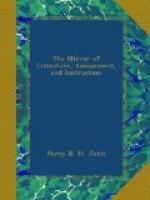* * * * *
SYMPATHY.
There is a tear, more sweet and soft
Than beauty’s smiling
lip of love;
By angel’s eyes first wept and oft
On earth by eyes like those
above:
It flows for virtue in distress.
It soothes, like hope, our
sufferings here;
’Twas given, and it is shed, to
bless—
’Tis sympathy’s
celestial tear.
Amulet.
* * * * *
MR. ABERNETHY
Was one day descanting upon the advantages of a public education for boys, when he concluded by saying, “And what think you of Eton? I think I shall send my son there to learn manners.” “It would have been as well, my dear,” responded his wife, “had you gone there too.”
* * * * *
ENGLISH BENEVOLENCE.
For several years previous to 1823, the crops in Ireland had been scanty, particularly those of potatoes. In 1821 the potato crop was a complete failure; and in 1822 it is impossible to tell, and dreadful to think, of what might have been the consequence, had not the English people come forward, and by the most stupendous act of national generosity which the world ever saw, and which none but a country so rich as England could afford, arrested “the plague of hunger,” which must otherwise have desolated the country.
* * * * *
PAINTING IN FRESCO.
The revival of this beautiful art is strongly recommended by a writer in the Edinburgh Review, for the internal decoration of private residences. “As we have begun to build houses upon a handsome scale in London, the lovers of art may venture to hope, that instead of spending enormous sums solely on the upholsterer for his fading ornaments, something may now be spared to the artist, for conferring on the walls unfading decorations of a far more delightful and intellectual kind. If the work be well executed, it will not suffer injury from being washed with clean and cold water.” The reviewer then goes on to suggest “small foundations, like the fellowships at our universities. The fellow, a young artist of promise, might spend two or three years in painting the interior of a church, or other public building, maintaining himself meanwhile on his fellowship, or two or three hundred pounds a year.” “If, however, the objections to painting our churches be deemed insuperable, we have buildings designed for civil purposes in abundance, which are well adapted for this species of decoration.” He then instances Westminster Hall, the walls of which might be covered with fresco; and the outsides of houses in many German cities and towns in the German cantons of Switzerland, the outsides of which are painted




